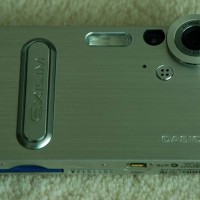I’m sorry that theVooner has been on a mini-sabbatical of sorts. This review in particular is long overdue as I’ve had the camera for sometime now. But, don’t blame me for lack of usage because I’ve really put this camera to the test – and its done really well.
Your options for digital cameras today run the entire gamut of options. You have lots of different options to choose from. After owning quite a different number of digital cameras, not to mention weighing all the different options, I have come to realize a few important factors that I think have gained prominence over time.
First, there is size. A small form digital camera has become increasingly important. Something good enough to put into a pocket or handbag is ideal. I feel that if a digital camera is small enough, you’ll want to take it along with you all the time – which means there are so many more opportunities to take pictures. In the past, you usually had to sacrifice quality at the expense of size. Even the Sony U-series that I own now only takes a mere 2MP picture which in a dimly-lit room is inadequate. It goes with saying that a small camera with a high resolution is ideal.
Secondly, another important factor today is the size of the LCD screen. This is importantly especially when you consider that: 1) sometimes, you just want to see if the picture came out or not and whether we should keep the photo or delete it. This is one of the biggest annoyances with the Sony U-series cameras. You can’t see the photo! There is no way to know if the image is clear, blurry, red-eyed or what. 2) You usually want to show the person(s) the photo that you just took or to share photos with other people. There is no way to do that with most digital camera LCD screens because they are just too small.
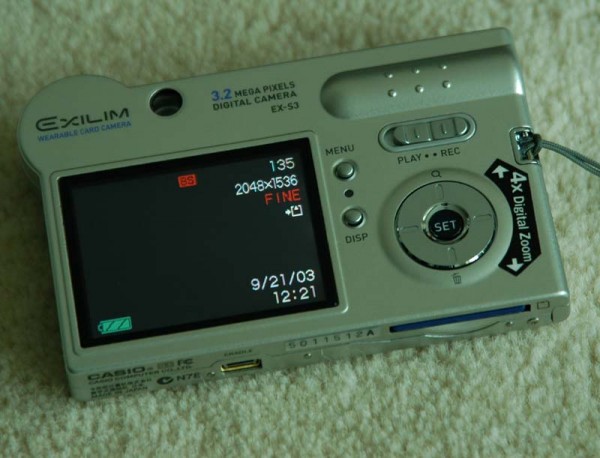
Casio Exilim S3 Digital Camera Back
Enter the Casio Exilim S3. The super small card-sized digital camera answers these concerns brilliantly. Even now months after its introduction, other manufacturers have yet to catch up which is why I can still comfortably write a review of it and talk about how brilliant it is. The S3 first of all is a reasonable 3.2 mega-pixel camera that I have found to be the minimum acceptable resolution for printable photos. Second, and more importantly, the S3 has a fantastically bright, and big 1.5″ LCD screen. The sheer size of this LCD screen is absolutely amazing, especially in contrast to other digital cameras. I cannot speak volumes about how different it is to be able to see the pictures that you have just taken. You can now actually see if the person’s eyes are open or closed! It’s also fun to take it out with you and share your photos with friends/family. People can actually see the photos now. It has changed the way I handle digital photography somewhat.
Form
The Casio S3 comes in the classic Exilim credit card sharp. The metallic shell is a typical coating and is extremely durable. It does not pick up scratches very easily as some other camera shells do. Again, as I said above, I have really only praise for this small, thin form factor. I can see how someone with big hands could potentially have some difficulty handling the camera. But its easily overcome. The small shape also means you have to look where you place your fingers when you take a picture, making sure not to block the lens or the flash when you take a picture. This wasn’t an issue with me, but if you give the camera to a stranger to take a picture of you, some of these pictures don’t turn out because they might not realize how their holding the camera.
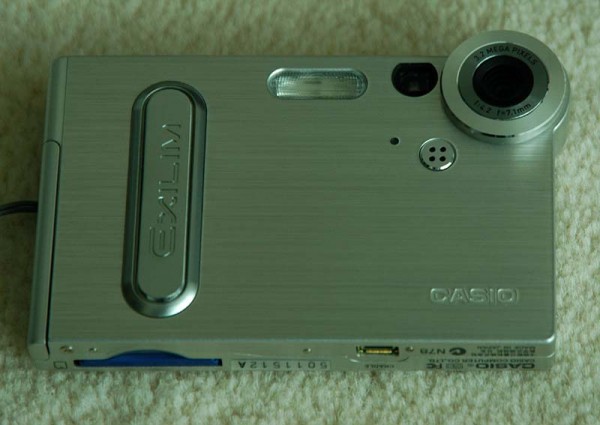
Casio Exilim S3 Digital Camera
There was some issue initially with the screen – I was worried that it might be too fragile — prone to either scratches or worse, like a cracked screen. But (knock on wood) nothing has yet to happen and its actually much more durable than you think.
Other than that, what more else is there? The buttons are all intuitively placed, especially the multi-directional pad that controls the camera, which is very easy to use and makes the menus easy to navigate. The S3 is so small that you can pretty much carry it anywhere. I would recommend a case though even though the outer shell is very durable.
Function
The S3 is a brilliant 3.2 mega-pixel digital camera. The reason I say that is not just because you get great photos from it, but because you get great photos from a tiny camera like the S3. Huh?! What I’m trying to say is that the S3 comes in a very small form, with a tiny lens on one side. When you see it, you think: “there’s no way this camera is going to take any decent shots”. But when you later see the pictures, you will be pretty impressed. Don’t get me wrong, lots of other cameras take much better photos, but given the size, its pretty spectacular.
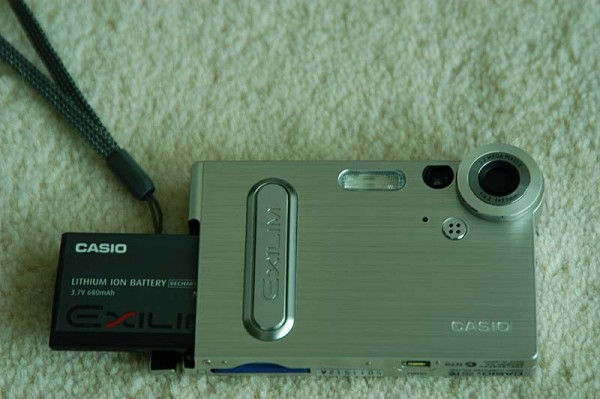
Casio Exilim S3 Digital Camera Battery
In contrast, you have a digital camera like the Sony U-20. Albeit it’s only 2.1MP, but you sort of just expect more. What is the point of having a small camera that you take pictures of at parties, etc. and none of the photos turn out? The S3 takes very good photos for its size. Even night/low-light photos come out well. On the average, most pictures are acceptable. The flash is powerful enough that even low-light photos come out decent. In fact, the flash can be so powerful that it can be a bit overpowering. You do have to adjust it yourself sometimes.
One thing I particularly like about the S3 is the different settings mode that comes preloaded with the camera. You have a selection of modes like portrait, sunset, fireworks, etc. You even get a few trick modes that allow you to take two different shots and combine them (side by side or on top of each other) which makes it pretty fun.
Picture quality is good enough that I’m more than happy printing any image with my printer, even without any post-photo adjustments. Of course, you can use Photoshop to enhance the overall pictures if you want, but I’ve been happy with a lot of the pictures. You should set this (and almost any digital camera) to the highest resolution and to the optimum quality (fine mode) to get the best from it. This of course will eat up memory so I just decided to buy a 256MB SD card, which costs quite a bit but it’s definitely worth it. I would recommend at least a 128MB SD card.
The S3 also takes video clips though you are limited to 30 second clips. In a dark room or at night, without the use of the flash, these clips are nearly worthless. But in the daylight or in a bright room, this could be fairly fun. I don’t use this function very often though.
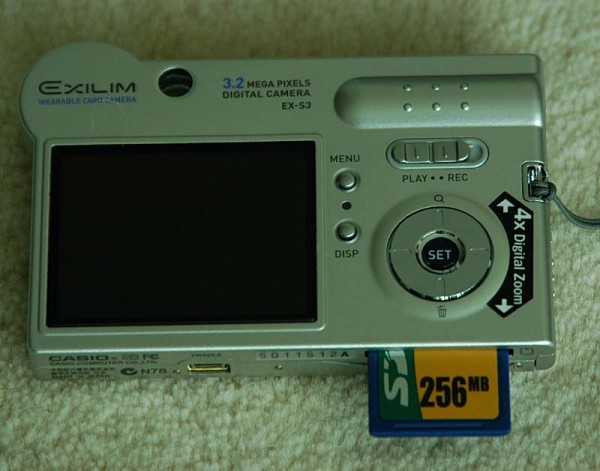
Casio Exilim S3 Digital Camera Data Card
Startup time for the camera is very fast and its quick to change from record to play mode with the click of a switch. With a larger than average screen, it’s easy to share many of the photos with friends, so the S3 comes with some useful features. First, you can organize the photos by the date you took them, so you know what photos were taken when and you can see that – they all appear on this calendar. Second, you can create different albums and then do different photo shows. You have a variety of options with in this regard. You can also edit some of the photos changing their orientation, size, etc. Lastly, and importantly, you can save your favorite photo to the built-in 10MB memory for permanent show. Pretty neat.
The S3 does not come with any optical zoom which helps it keep its small size. You can buy the Z3 if you want a zoom or the new Z4 (bigger screen, 4 mega-pixels). But a zoom comes at the expense of size and the Z series is nearly twice as fat (well it feels that way). The S3 in turn actually comes with a digital zoom, but at 4x, this is pretty worthless because the images are horrible. Stick with the normal resolution and work around NOT having a zoom.
So almost everything is pretty good with the photos, but there is one rather annoying problem – the S3 has to be charged on the cradle that it comes with. I prefer to use a quick card reader rather than install all of the software that came with it (both my computers have enough programs thank you very much). As a result, I don’t use the cradle to connect the S3 to my PC to download the pictures. Nevertheless, the cradle has to be used to charge the camera – and that includes taking it along on trips. It is slightly annoying that I have to carry along the cradle as well as the adapter unit when I travel. You could buy the optional external battery charger, but I guess my point is you shouldn’t have to buy something extra just to make it useful. The camera is so small, but you have to carry around an adapter and a cradle which makes the whole thing double in size when you travel.
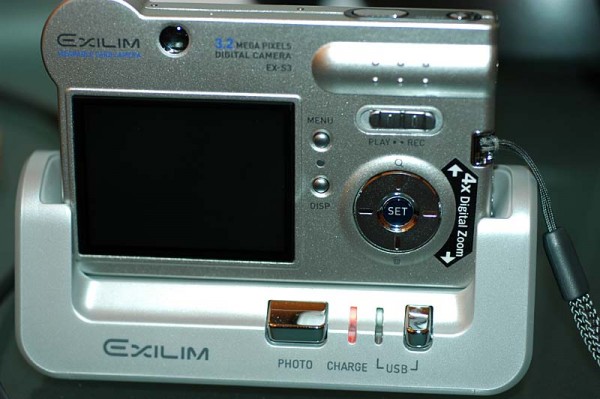
Casio Exilim S3 Digital Camera Cradle
In terms of overall battery life, the camera is very good. I’m not sure what’s the maximum life the battery can handle, but I took over 100 pictures and the battery still had power (from a full charge) so its not a concern for me. I would have thought the screen would have eaten up a lot of power but it didn’t seem to (at least to the point where it was going to be a problem anyways).
Factor
Overall, I don’t know how to praise the S3 enough. I have had many digital cameras, and it’s been many months since I first bought the S3. Still, I continue to recommend it. When an S4 or S5 comes out, I’ll buy/recommend that too without reservation. For its sheer size which makes this an absolutely ESSENTIAL item, you can’t do any better. Even if this were to be your only digital camera, I’d still say go get it. It’s just that much fun and good.
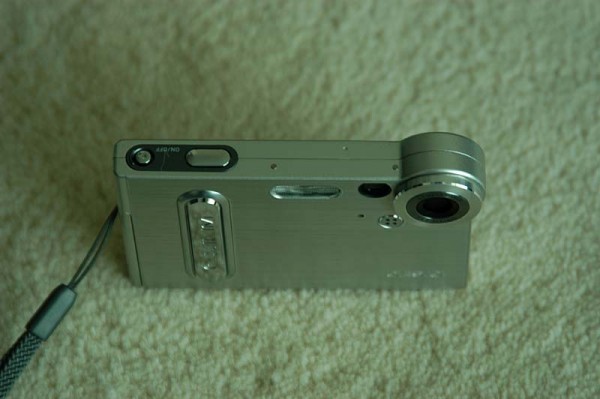
Casio Exilim S3 Digital Camera Top
